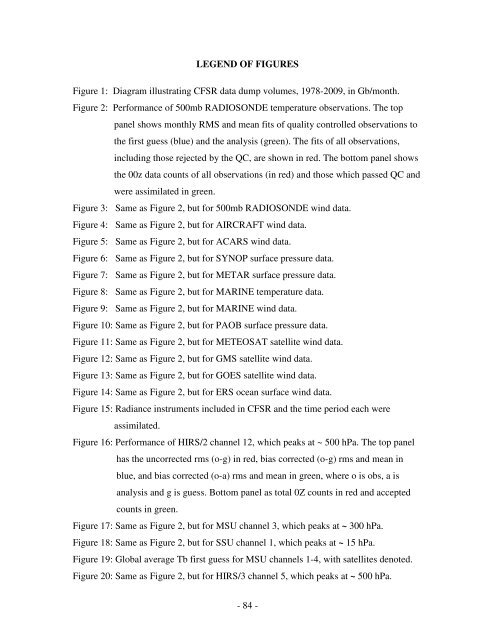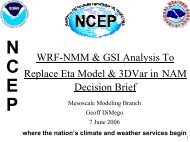The NCEP Climate Forecast System Reanalysis - NOAA National ...
The NCEP Climate Forecast System Reanalysis - NOAA National ...
The NCEP Climate Forecast System Reanalysis - NOAA National ...
You also want an ePaper? Increase the reach of your titles
YUMPU automatically turns print PDFs into web optimized ePapers that Google loves.
LEGEND OF FIGURESFigure 1: Diagram illustrating CFSR data dump volumes, 1978-2009, in Gb/month.Figure 2: Performance of 500mb RADIOSONDE temperature observations. <strong>The</strong> toppanel shows monthly RMS and mean fits of quality controlled observations tothe first guess (blue) and the analysis (green). <strong>The</strong> fits of all observations,including those rejected by the QC, are shown in red. <strong>The</strong> bottom panel showsthe 00z data counts of all observations (in red) and those which passed QC andwere assimilated in green.Figure 3: Same as Figure 2, but for 500mb RADIOSONDE wind data.Figure 4: Same as Figure 2, but for AIRCRAFT wind data.Figure 5: Same as Figure 2, but for ACARS wind data.Figure 6: Same as Figure 2, but for SYNOP surface pressure data.Figure 7: Same as Figure 2, but for METAR surface pressure data.Figure 8: Same as Figure 2, but for MARINE temperature data.Figure 9: Same as Figure 2, but for MARINE wind data.Figure 10: Same as Figure 2, but for PAOB surface pressure data.Figure 11: Same as Figure 2, but for METEOSAT satellite wind data.Figure 12: Same as Figure 2, but for GMS satellite wind data.Figure 13: Same as Figure 2, but for GOES satellite wind data.Figure 14: Same as Figure 2, but for ERS ocean surface wind data.Figure 15: Radiance instruments included in CFSR and the time period each wereassimilated.Figure 16: Performance of HIRS/2 channel 12, which peaks at ~ 500 hPa. <strong>The</strong> top panelhas the uncorrected rms (o-g) in red, bias corrected (o-g) rms and mean inblue, and bias corrected (o-a) rms and mean in green, where o is obs, a isanalysis and g is guess. Bottom panel as total 0Z counts in red and acceptedcounts in green.Figure 17: Same as Figure 2, but for MSU channel 3, which peaks at ~ 300 hPa.Figure 18: Same as Figure 2, but for SSU channel 1, which peaks at ~ 15 hPa.Figure 19: Global average Tb first guess for MSU channels 1-4, with satellites denoted.Figure 20: Same as Figure 2, but for HIRS/3 channel 5, which peaks at ~ 500 hPa.- 84 -





